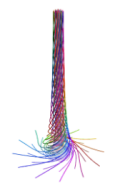Mackenzie, Dana - Belle [D31]
US Amateur Team Championship, 21.02.1983
The game below was played at the U.S. Amateur Team Championship in 1983. I
was playing for the Princeton University team, and we were paired against a team
from Bell Laboratories. One of the "players" on the Bell Labs team was Belle, a
dedicated chess computer that was built by the legendary computer scientist Ken
Thompson.
At the time of this game, Belle was the world computer champion, and had
recently become the first chess computer ever to achieve a master rating in
tournament competition. As it turned out, Thompson more or less retired Belle
from tournament competition after 1983, so this was one of the last games of its
"career." My victory in this game is one of my most treasured chess
accomplishments, and an opportunity that will never be repeated.
There's one other cool thing about this game. A couple weeks after it was
played, Ken Thompson sent me a printout of Belle's analysis! The printout shows
how much time Belle took on each move, its evaluation of the position, and also what moves it considered best at each "ply" of analysis. (A "ply" is half a move, so when Belle was analyzing at a depth of 4 ply, it was looking 2 moves deep.) Even
though it had dedicated hardware, Belle was slow enough that it never looked more than 10 plies (5 moves) ahead. Today's chess computers routinely look that deep in seconds.
Recently, as an experiment, I re-analyzed the game with Fritz 9, one of
today's top commercial chess computers, giving it the same amount of time on
each move as Belle took. In some ways, comparing the two computers is actually
more interesting than watching the game itself.
1.d4 d5 2.c4 e6 3.Nc3 c6 4.e4 dxe4 5.Nxe4 Bb4+ 6.Nc3 ...
I was unfamiliar with this variation, and did not know about Bronstein's
gambit 6.Bd2!? Qxd4 7.Bxb4 Qxe4+ 8.Be2! But my ignorance may have worked in my
favor, because the game would have proceeded more along tactical lines, where
the computer would be stronger.
6...Nf6 7.Nf3 0-0
This is the first move where Belle was out of its book and had to find its own move. Fritz would have played 7. ... c5 right away.
8.Bd3 c5 9.0-0 cxd4 10.Nxd4!? ...
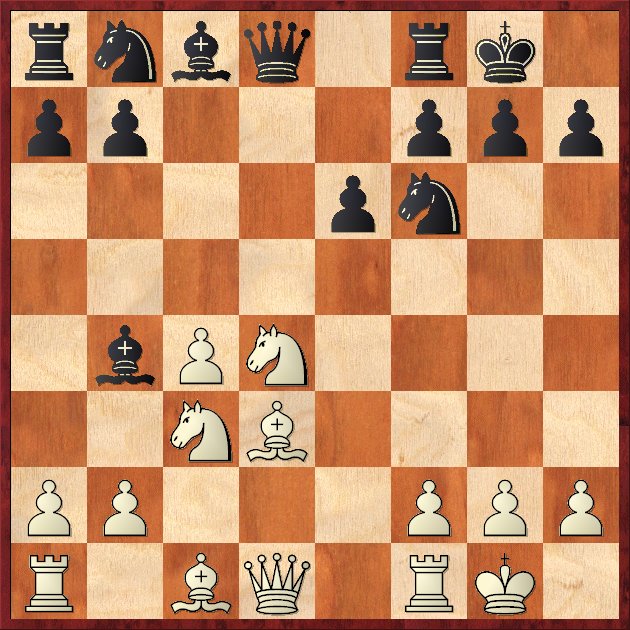
A very interesting moment in terms of chess strategy. White could have avoided the doubling of his pawns with
10.Ne2. However, I actually wanted to lure Black into doubling my pawns, because
I felt that it would give me very active piece play. At this point in my career
I had a theory that doubled pawns are not always as weak as many people think,
and I suspected that the programmers might have given Belle the same prejudice
against doubled pawns that most players have.
10...Bxc3?!
Belle takes the bait! Fritz prefers 10. ... Nbd7, by the way.
11.bxc3 e5 12.Nb5 e4?
This is the mistake that really gets Belle into hot water. Fritz prefers 12. ... Bg4. Belle's opening play
was clearly inferior to Fritz's. It neglected its development, and gave too high a priority to
attacking without thinking of the positional consequences (here, putting a pawn on the color of its remaining bishop). At this point Fritz's evaluation and Belle's start to diverge. Belle gives Black a 0.12-pawn advantage, while Fritz gives White a 0.43-pawn advantage. This pattern continued for the rest of the game -- Belle and Fritz mostly found the same moves, but Belle overestimated its chances.
13.Bc2 Qa5 14.Bf4 Nc6
Fritz would have played 14. ... Bg4 here. Up to this point Fritz and Belle have disagreed several times, but after this move they agree on 20 out of 22 moves, and "almost" agree on the other two.
15.Nc7 Bg4 16.Qb1 Rad8 17.Qxb7 ...
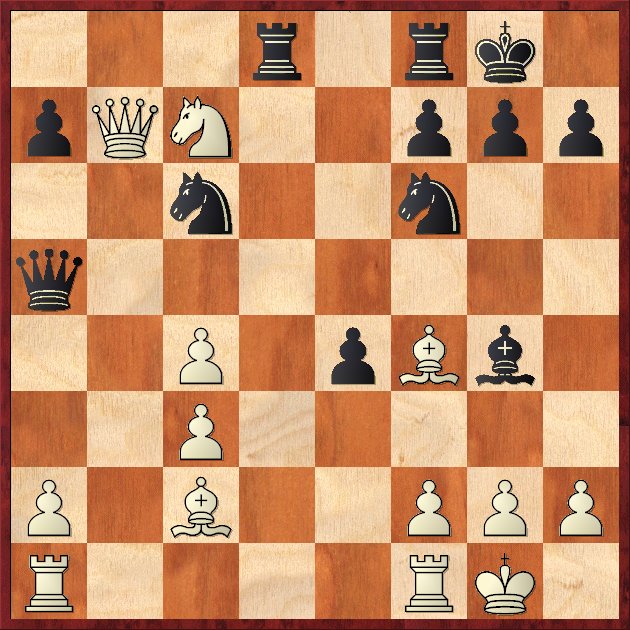
In spite of my efforts, the game is now proceeding along very tactical lines. I remember at this point feeling totally confused, but nevertheless I did not think I could possibly be worse, because of my very active pieces. Fritz and Belle agree: Fritz rates the position 0.99 pawns in White's favor, and Belle now sees it as 0.46 pawns in White's favor.
17...Qxc3 18.Qxc6 Qxc2 19.Bd6 Rxd6 20.Qxd6 Qxc4
Psychologically it was very important to me that I now had a tangible material advantage. Belle sees a 0.53-pawn edge for White, Fritz sees it as 0.56 pawns -- both in agreement with the conventional wisdom that a rook for a bishop and pawn is a "half-pawn" advantage.
21.Rfc1 Qa4
An interesting thing is revealed by Thompson's printout: Belle changed its mind
five times on this move! It vacillated between the text move and 21. ... Qd3, which Fritz prefers.
22.Nd5 Nxd5 23.Qxd5 Be6 24.Qe5 ...
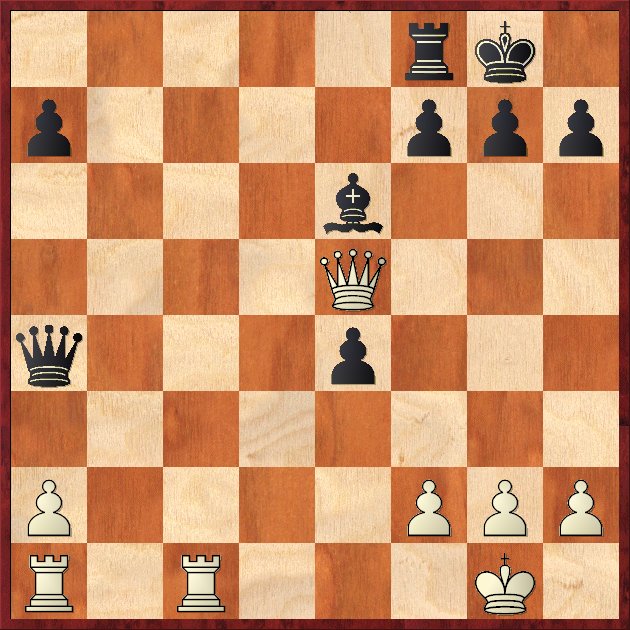
24. ... Rd8?
Here is the only other place between moves 14 and 37 where Fritz and Belle disagree. Once again, Belle debated between this move and the move Fritz prefers, 24. ... Re8. This time it definitely chose wrong. This may seem surprising: Don't rooks belong on open files? Yes, but in this case White's next move is going to completely tie Black's pieces down to passive defense. By contrast, 24. ... Re8 threatens a discovered attack on White's queen and kind of makes White's last move look
stupid. A very tricky position that I think a lot of humans would have misjudged, too!
25.Re1 Bd5 26.Red1 ...
Ouch! This is a nasty pin. White is now in complete control. Fritz says White is ahead by 1.99 pawns. Belle is still oblivious, and thinks that it is only 0.51 pawns behind.
26. ... f6 27.Qc7?! ...
This is my most significant inaccuracy of the game. I had a much better move: 27.Qd4! after which the pressure on the d-file is absolutely decisive. For example, 27...Qxd4 (or 27...Qd7 28.Rac1 threatening 29. Rc5)
28.Rxd4 Kf7 29.Rad1 Ke6 30.Rxe4+! snags a big pawn.
27...Rd7 28.Qc8+ Kf7 29.h3 ...
A useful precautionary move, preventing any back-rank mates.
29...Be6 30.Rxd7+ Qxd7?!
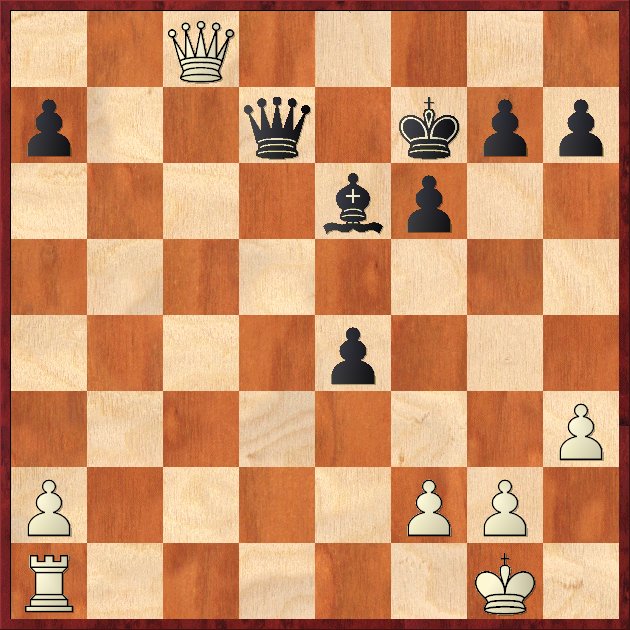
I was stunned during the game when Belle played this move, and stunned again to see that Fritz agrees with it! This shows a huge difference between computer and human thinking. In my opinion, this move trades down to an endgame that is dead lost for Black. But the computer programs (both of them) apparently feel that
White's potential for a queen-rook battery on the seventh or eighth rank poses a greater danger. Okay, I guess they're right:
That would end the game faster. Still, if I were black there is no question I would have kept the queens on the board, hoping for a miracle. After this move there is no hope for Black.
31.Qxd7+ Bxd7 32.Rb1 a5 33.Rb7 Ke6 34.Ra7 a4 35.Kf1 f5 36.Ke2 f4 37.Kd2 g6
This is the point at which Belle and Fritz start disagreeing again. Fritz would have played 37. ... g5. It scarcely makes any difference. Black cannot prevent White's king from circling around to d4 and winning Black's too-far advanced pawns.
38.Kc3 f3 39.gxf3 exf3 40.Kd4 h6 41.Ra6+ Kf7 42.Ke3 Bxh3 43.Rxa4 Bg2?
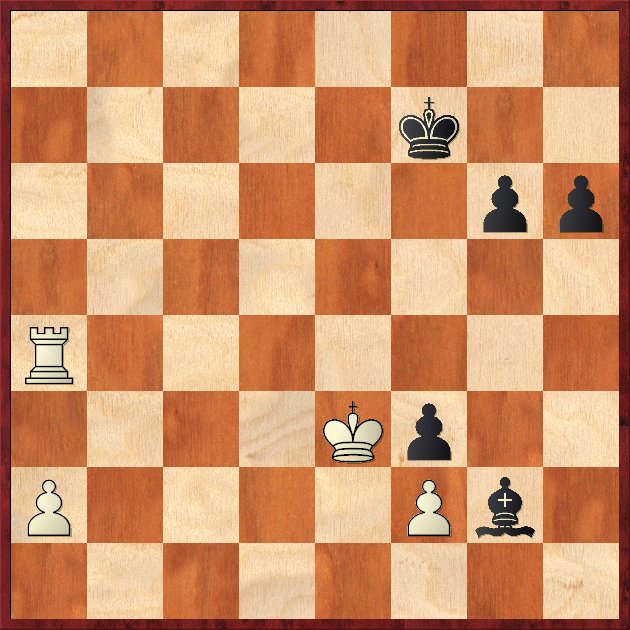
A horrendous case of the "horizon effect," caused by the fact that Belle cannot look more than 10 plies ahead. Any human player can look at the board and see in one glance that this move cuts the bishop off from the queenside and allows White's a-pawn to march down the board unimpeded. However, Belle couldn't see this because the pawn takes more than 10 plies to reach the queening square. Fritz does not have this "horizon effect" (or else, its horizon is much farther
off than Belle's was).
44.Rd4 h5 45.a4 Ke6 46.Rd1 Ke5 47.a5 Bh3
Too late.
48.a6 Bc8 49.a7 Bb7 50.Rd8 1-0
Here Thompson resigned on the machine's behalf.
Fritz's understanding of the opening seems better than that of its
predecessor. In the middlegame their play would have been virtually identical.
If Belle had possessed fast enough hardware to look as far ahead as Fritz does,
it probably would not have made the decisive mistake on move 24. In the endgame
Belle had a severe "horizon effect," but I suspect this was entirely due to the
hardware limitations. In this game at least, it would seem that the Fritz
software is not superior to Belle, except possibly in the opening.
The two machines have a profound "genetic similarity" to each other, which is
reflected in the fact that Fritz correctly predicted many more of Belle's moves
than my moves. Leaving out the six "book moves" in the opening, Fritz predicts
30 out of Belle's 43 moves (70 percent) correctly, with most of the
disagreements coming either in the opening or in the endgame when the game was
already basically over. On the other hand, Fritz correctly predicts only 23 of
my 43 moves over the same period (53 percent).
In retrospect, I was somewhat lucky in this game to have a clear-cut
strategic plan and, after move 20, a comfortable material and positional
advantage. That's why I was able to get away with so many moves that were (in
Fritz's opinion, at least) not the absolute best. A particularly dramatic
example is the queen trade on move 31, which Fritz considers to be not best, but
which in fact gives White a simply won game. |
